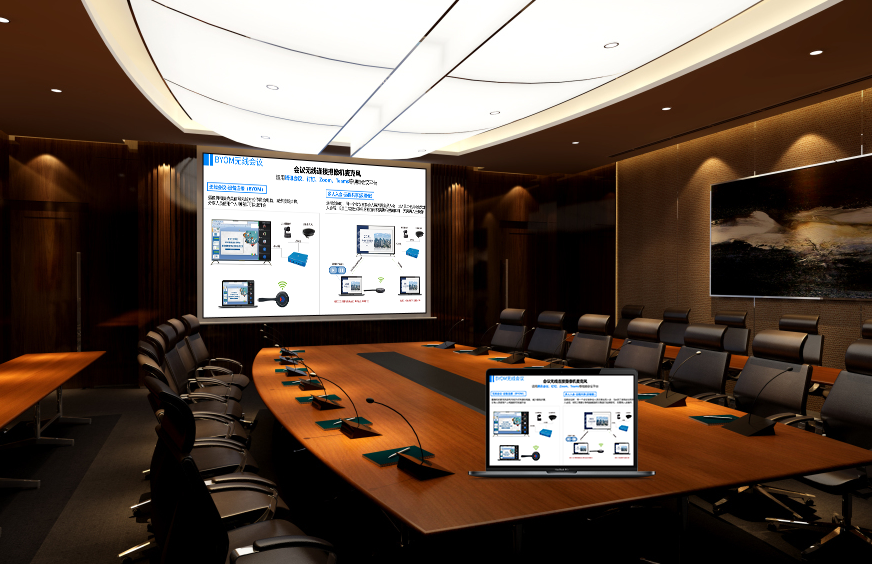Whether it’s a Windows laptop, desktop, or macOS-equipped Apple computer, no additional dedicated software is required. Using the device’s built-in mirroring functions (such as Windows’ “Project” or macOS’ “Screen Mirroring”), you can quickly match the mirroring receiver. Search for the corresponding device, click connect, and pairing is completed within 3-5 seconds — as simple as connecting to WiFi, even for computer beginners. For example, in an office setting, new employees can quickly mirror their onboarding training materials to the meeting room’s large screen by following on-screen prompts.
In addition to wireless mirroring, HDMI wired connection ports are also available. When meeting room network signals are unstable and wireless mirroring is interfered with, simply connect the computer to the mirroring device with an HDMI cable to achieve stable mirroring instantly — avoiding meeting delays due to network issues. In home entertainment scenarios, wireless mirroring eliminates cable restrictions, allowing more flexible computer placement; you can easily mirror movies to the TV even while lounging on the sofa.
Supports 4K ultra-high-definition mirroring (compatible with computers with 4K output capabilities). Whether it’s design drawings, data reports, 4K movies, or high-definition documentaries on your computer, details are accurately reproduced. The 画面 features vibrant colors and sharp edges with no blurring or motion trailing — perfect for design professionals showcasing work and financial staff presenting data, allowing viewers to intuitively experience the high quality of the content.
Wireless mirroring latency is controlled within 20ms, ensuring smooth playback of videos and design software operation. For example, when demonstrating PPT animations via computer mirroring, page transitions and animations play in perfect synchronization with no “delayed 画面”. When playing light computer games, operation commands sync in real-time with the large screen, delivering a smooth gaming experience. Even with multiple devices connected to the same network, built-in signal optimization technology avoids interference, ensuring stable and uninterrupted mirroring.

During meetings, participants can directly share proposals via computer mirroring — no need for frequent file copying to USB drives. Set the large screen as an “extended display” to edit documents on the computer’s main screen while displaying reference materials on the secondary screen (large screen), making multi-tasking more efficient. In multi-person collaboration, different computers can take turns mirroring with quick, lag-free transitions, saving meeting time.
For remote work, mirroring computer screens to large displays combined with video conferencing software allows clearer presentation of document details when communicating with off-site colleagues — creating a “face-to-face” collaboration experience.
Teachers can mirror and explain courseware from their computers, with real-time annotations on key points that 同步 display on the large screen — attracting students’ attention. High-definition playback of educational videos makes knowledge points easier to understand, improving classroom teaching effectiveness.
During student group discussions, computer mirroring of group projects facilitates teacher and peer reviews, enhancing classroom interaction.
On weekends at home, mirror movies and TV shows from your computer to the TV. The large screen offers a more immersive viewing experience than a computer monitor, and paired with home speakers, creates a cinema-like atmosphere. You can also mirror computer photos and family videos to the TV, allowing the whole family to revisit precious moments together.
When children attend online classes on computers, mirroring to a large screen prevents eye strain from prolonged small-screen viewing, while high-definition 画面 makes learning content clearer.
Supports device permission management, allowing only authorized computers to mirror — preventing content leakage from unauthorized device connections. Temporary visitors need a one-time authorization code to mirror from their computers, which automatically expires after use — providing security for both office and home environments.
Mirroring devices allow viewing connected computer lists on mobile phones, with one-click disconnection of unauthorized connections. Some models feature “mirroring memory” — frequently used computers receive automatic connection prompts upon startup without re-searching, simplifying operations. The compact device only requires power and HDMI connections to large screens (only power for wireless mirroring), with no complex installation — convenient for both home and office use.
From office collaboration to home entertainment, from education to professional presentations, computer screen mirroring — with its advantages of “easy connection, HD stability, and multi-scenario adaptation” — makes computer content more accessible on large screens. It has become a practical tool for improving efficiency and enriching experiences, meeting
computer mirroring needs across various scenarios.


